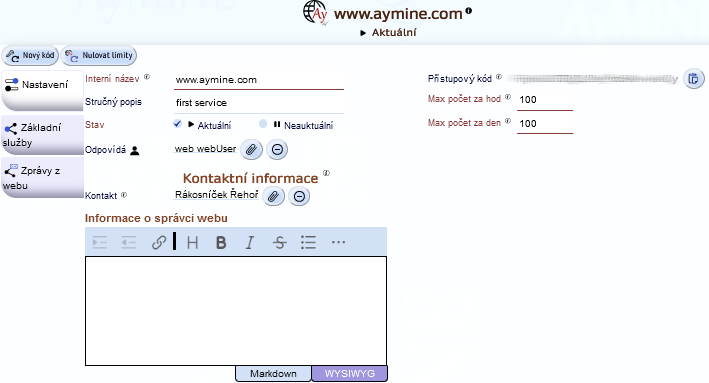AyMINE – Technischer Bericht (Englisch)
Module
 Aufgaben-, Projekt- und Qualitätsmanagement
Aufgaben-, Projekt- und Qualitätsmanagement
 Aufgaben-, Projekt- und Qualitätsmanagement
Aufgaben-, Projekt- und Qualitätsmanagement
Systemrechte für das Task-Management-Modul
Task Management Modul Verwaltung
Benachrichtigungen und Nachrichten
Benachrichtigungen an sich selbst
FMEA – Auftretenswahrscheinlichkeit
FMEA – Wahrscheinlichkeit der Entdeckung
Fehleranalyse für eine einzelne Eigenschaft eines Bauteils oder Prozesses
Methodik und Qualitätsmanagementsystem
Probleme, Tickets und ihre Verwaltung
8D report – Systemunterstützung
Kundenservice Antwortgenerierung
Qualifikation, Fähigkeit / Geschicklichkeit
GDPR und Verzeichnis der Qualifikationen
Qualifikation des Benutzers oder Kontakt
Rechte zur Verwaltung der Qualifikationen von Nutzern
 Kontakte, Verzeichnisse
Kontakte, Verzeichnisse
System-Berechtigungen und CRM-Modul-Einstellungen
Adressbuch von Personen und Firmen
Massenversand von Nachrichten in Übereinstimmung mit der GDPR
Melden Sie sich ab und stellen Sie Einstellungen ein
für Massenmails
Wie man die Daten einer Person richtig vergisst
 Web-Management und Automatisierung
Web-Management und Automatisierung
 Web-Management und Automatisierung
Web-Management und Automatisierung
Benutzerdokumentation für AyMINE
Empfangen einer Nachricht über das Web
Grundlegende Service-Einstellungen
Zugriff auf eine Website speichern
HR-Modul
Abteilung verwalten / division data
Personalistics – Benutzerberechtigungen
Registrierung von Arbeitsuchenden
Sicherheit der Personalverwaltung
Ein Überblick über Ihr eigenes Mitarbeiter
Synchronisierende Mitarbeiter und Benutzer des Systems
 Produkte, Vermögenswerte, Kauf und Verkauf
Produkte, Vermögenswerte, Kauf und Verkauf
 Produkte, Vermögenswerte, Kauf und Verkauf
Produkte, Vermögenswerte, Kauf und Verkauf
Angebot und Preis Zugriffsrecht
Erhaltener Auftrag für Waren oder Dienstleistungen
Produkteigenschaft oder Produktelement
Finanzmanagement
Metriken und Messungen
Technische Module
Sabre-Modul
Konnektor zwischen AyMINE und Enterprise Architect
Datenbanklink zur Enterprise Architect Datenbank
Konnektor zwischen AyMINE und Enterprise Architect
Systemmodule
 Framework – Systembasis
Framework – Systembasis
Richtlinie zur Aufbewahrung von Passwörtern
Überblick über Module und Datentypen
AyMINE — Anwendung für Windows
Drag & Drop zwischen den Datensätzen
Gesten und Tastenkombinationen
Konfigurieren Sie, wie Ihr System aussieht und funktioniert
Mehr darüber, wie das System funktioniert
Private Notizen und Tags für Objekte
 Systemverwaltung
Systemverwaltung
Beziehungen zwischen den Datensätzen
Formatierte Texte in der Anwendung
Gateway-Einstellungen für externe -Nachrichten
Regeln für externe Nachrichten
Sichere Geschäftskommunikation
Konnektor für Webdienste
AyMINE ermöglicht es Kunden, den Konnektor für die Webkommunikation anzupassen. Hierfür werden WEB-Konnektoren verwendet.
Die Einstellungen des Connectors sind für Administratoren zugänglich. Der Pfad zur Einrichtung lautet:
Desktop-Hauptmenü (Menü) → Administration → Systemeinstellungen → WEB-Konnektoren (Lesezeichen)
Was ist ein Web-Konnektor
Ein Web-Konnektor ist eine Verbindung, die es anderen Anwendungen – z.B. Webseiten – ermöglicht, mit AyMINE zu kommunizieren, Informationen zu empfangen und Daten an AyMINE zu übermitteln. Man kann sagen, dass er eine Tür zu Informationen ist. AyMINE stellt die grundlegenden Konnektoren innerhalb eines Web Service Moduls zur Verfügung.

Natürlich wird AyMINE keine Informationen an irgendjemanden oder irgendetwas weitergeben, ohne jemandem einen Schlüssel zur Tür zu geben. Wenn Sie eine Verbindung erstellen, erstellen Sie nicht wirklich eine Verbindung – sie ist im System programmiert, aber Sie machen einen Schlüssel zur Tür zu Ihren Daten. Und es liegt an Ihnen, wem Sie den Schlüssel geben.
Sie können so viele Schlüssel erstellen, wie Sie wollen. Wir empfehlen Ihnen, jeden Schlüssel nur für einen Benutzer zu verwenden – eine externe Anwendung oder eine Website. Bei Bedarf können Sie den Schlüssel leicht wieder entfernen.
Was Sie für den Konnektor einstellen müssen
Für die Einrichtung des Konnektors ist ein Minimum an Daten erforderlich, die leicht zu verstehen sind. Deshalb hier nur ein paar Hinweise
- Naming – Wir empfehlen den Namen der Anwendung oder Website, die den Konnektor verwendet. Wenn eine Nachricht über den Konnektor vom Web zum System geht, ist der Name Teil der Nachricht. Es ist daher ratsam, den Namen für diejenigen, die die Nachrichten erhalten, verständlich zu machen
- Zugangscode – generiert das System automatisch und Sie können ihn nicht selbst definieren. Der Zugangscode muss dem Administrator der Anwendung bekannt sein, um sich mit AyMINE zu verbinden.
- Maximum counts – Die Werte legen fest, wie oft pro Stunde oder Tag der Service aufgerufen werden kann. Es wird empfohlen, ein der Nutzung entsprechendes Limit zu setzen. Der Grund für die Begrenzung ist der Schutz vor Angriffen aus dem Internet. Die Begrenzungen können nicht vollständig aufgehoben werden.
- Kontakt – Sie können den Kontakt aus dem Adressbuch mit der Person verbinden, die für den Anschluss "auf der anderen Seite" zuständig ist – für die verbundene Anwendung. Der Kontakt ermöglicht es Ihnen, Probleme schnell zu lösen, wenn sie auftreten. Das Kontaktfeld ist nur verfügbar, wenn Sie das CRM-Modul verwenden.
Funktionen
Die Schaltflächen oben links bieten Funktionen.
Der neue Code generiert einen neuen Zugangscode. Nur verwenden, wenn der aktuelle Code gefährdet ist.
Nullgrenzen__ Wenn aus irgendeinem Grund die Nachrichtengrenzen pro Stunde oder Tag erreicht wurden, können Sie die Zähler auf Null zurücksetzen. Dadurch wird die blockierte Tür wieder freigegeben.
Konnektor vs. Dienst
Die Datentür – der Konnektor – gibt das Zugriffsrecht, aber Sie müssen noch festlegen, auf welche Daten durch diese Tür zugegriffen werden soll. Nachdem die Verbindung hergestellt ist, müssen Sie noch die Dienste einrichten, die "an der Tür" verfügbar sein sollen. Jede Tür wird separat eingerichtet.
Services
Zum Basispaket der Webdienste gehören:
Dienste nicht versehentlich löschen
Wenn Sie den Konnektor löschen, werden auch die Dienste entfernt. Wenn Sie den Anschluss nur vorübergehend sperren wollen, löschen Sie ihn nicht, sondern ändern Sie den Status auf "veraltet".